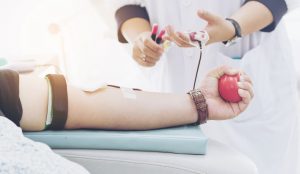It was recently reported that blood supplies in the UK will last – at best – just a few days. In 2018, the NHS Blood Service has tried to encourage donations from new donors and ethnic minorities but also focusing on people with rare blood types where stocks are critically low. If you’re considering giving blood for the first time, this is what you can expect to happen leading up your donation and on the day.
Signing Up for Blood Donation
Registering for blood donation really could not be easier. You can use the dedicated website or alternatively download the app. This is the fastest way of finding out where you can donate and when. Once you’ve filled out your personal details (name, DOB, address etc.), you are asked a series of questions about your general health. If you pass (and most people will) you are presented with a list of upcoming blood donations and dates. Simply select a date and wait.
Alternatively, call 0300 123 23 23.
Leading up the Donation
Around 1-2 weeks before your donation, you’ll receive a questionnaire in the post. Some questions are personal enquiring which medication you are taking, when you last saw a doctor, your sexual history, and whether you have a history of drug use. It’s vital that you fill out the entire questionnaire honestly. Take the completed questionnaire on the day and make sure you follow the guidelines about eating and drinking, getting plenty of fluids beforehand.
The Day of Your Donation
Upon arrival, you will be greeted at the door by a receptionist who will look over your questionnaire to ensure everything is in order. They will not query it; their job is to ensure you have brought all the relevant information. Once cleared, they will ask you to sit in the waiting area and wait to be called. This is your last chance before donating to take in some fluid. Please do so – you’re going to feel quite dehydrated afterwards if you don’t drink plenty of water now.
Your wait depends on how busy the donation centre is at the time of your arrival. You could be called almost immediately but it’s rarely longer than 30 minutes. Next, you will be called to speak to a healthcare assistant about the answers to your questionnaire. If there are any anomalies or issues of concern, you may also see a nurse. Don’t worry, they are usually looking for reassurances and it’s unlikely at this stage (unless you’ve been ill very recently) that you’ll be turned away.
The Donation Period
Once the HCA and/or nurse is satisfied, they will take you to the donation area where you will be seated in a reclining chair and asked to place your arm on what looks like a side table. Here, you will meet a nurse (it may be the same one) who will talk you through the process calmly and provide advice on what to do – mostly that you should clench and relax your muscles throughout to keep the blood flowing. They will then connect you up to a device to start taking your blood. You’ll feel a slight sting, no more or less painful than when taking a blood sample for a blood test.
It should take 10-15 minutes to withdraw the 1 pint of blood. When finished, the device will beep and the nurse will return to remove it from your arm. It is vital that you do not stand up until you’ve had some fluid and time to recovery. Stand up slowly and proceed to the after-care area where you’ll be provided with more cold drinks and biscuits. You need this time to rest and recover so don’t rush out the door until you feel ready. You should also not engage in any heavy lifting or exercise for the rest of the day.
Also, you should not ingest caffeine or alcohol for at least 6 hours as these will have a greater effect than normal.
